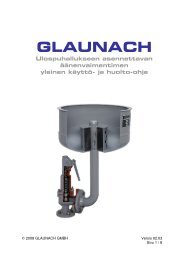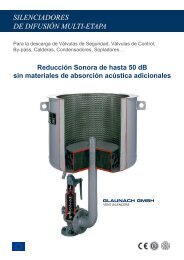1. acoustic dimensioning - GLAUNACH Vent Silencers
1. acoustic dimensioning - GLAUNACH Vent Silencers
1. acoustic dimensioning - GLAUNACH Vent Silencers
Create successful ePaper yourself
Turn your PDF publications into a flip-book with our unique Google optimized e-Paper software.
<strong>1.</strong>6 CONDUCTING NOISE CONTROL MEASUREMENTS<br />
acc. to ISO/DIS 11820.2 – Acoustic Measurements on <strong>Silencers</strong> in-situ<br />
THE SILENCER HANDBOOK<br />
Part IV | page 11 of 14<br />
This standard provides a good guideline for how to measure the actual sound<br />
pressure levels Lr at the reference points.<br />
The standard specifies in-situ measurement procedures of (ducted) silencers,<br />
including blow-off silencers (chapter <strong>1.</strong>2-b). This includes recommendations for the<br />
arrangement of the measuring points for different installation conditions:<br />
Axial measurement: The standard requires that measuring points be arranged<br />
on the silencer axis in front of the blow-off outlet. With blow-off silencers,<br />
however, the medium flows out of the silencer outlet at high velocities and<br />
possibly high temperatures. Thus, it is not recommend that sound meters be<br />
arranged in the gas path at the silencer outlet.<br />
Lateral measurement: With blow-off silencers, the more common<br />
arrangement is to arrange at least one point of reference laterally, i.e. adjacent<br />
to or below the silencer opening.<br />
For installations requiring a point of reference over the silencer opening, the lateral<br />
reference point can be related to the required in-axis values by applying a direction<br />
correction function.<br />
The standard furthermore prescribes the measurement conditions; the table<br />
“Corrections for Background Noise” stipulates that the background sound<br />
pressure level must be more than 3 dB lower than that of the measured<br />
operating sound source during the test. When measuring a silencer, this means<br />
that all other noise emissions, including such related to flow noise from pipes and<br />
valves, must be accordingly lower.<br />
Legal and customer requirements often demand silencers to achieve extremely<br />
low silenced levels, e.g. 85 dB(A) at a lateral position 1 m from the silencer<br />
opening. While this is achievable with modern vent silencers, in practice the<br />
performance of the silencer is often overlaid with noise emitted from less than<br />
ideally installed elements nearby. Site visits reveal that e.g. blow-off pipes between<br />
silencer and roof or valve are not insulated, or the valve is outside and radiates<br />
noise. Yet, the noise contributions from these sources are often overlooked.<br />
Please note that according ISO/DIS 11820.2, the control measurement<br />
is invalid under such conditions!<br />
2. THERMAL DIMENSIONING<br />
In addition to the correct material selection for the silencer 1) , the thermal expansion<br />
in particular of the piping leading to the silencer may have to be taken into account.<br />
The thermal expansion can be derived using the standard formula:<br />
∆l = l×α×∆T×10 -6 [m]<br />
1) see Part V – Materials & Standards of THE SILENCER HANDBOOK<br />
© <strong>GLAUNACH</strong> GMBH Edition 2010








